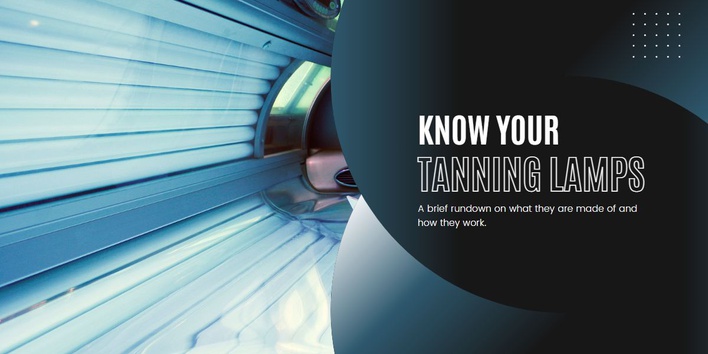Know Your Lamps

What are tanning lamps?
Tanning lamps, also known as UV lamps, are specifically designed to emit ultraviolet (UV) radiation, which is a kind of light that can't be seen with our eyes. These UV rays are used in tanning beds, booths, and sunbeds to make our skin darker, like when we go outside in the sun.
The process of making tanning lamps typically begins with the creation of the bulb, which is the primary source of light in the lamp. The bulb of a tanning lamp is usually made of glass and is filled with a gas, such as argon, and a small amount of mercury vapor.
When an electrical current energizes the bulb, the gas and mercury vapor creates a discharge, generating ultraviolet radiation. The specific wavelength and intensity of the UV radiation emitted by the bulb are determined by the type of gas and the amount of mercury vapor used in the bulb, as well as the design of the bulb itself.
Different types of tanning lamps may use different types and concentrations of gases, different reflector designs, and different bulb designs. All of that affects the specific type and intensity of the UV radiation emitted by the lamp. It's important to choose the appropriate type of lamp for your skin type and use it according to the recommended guidelines to avoid any potential damage to the skin.
What is a reflector?
Some tanning beds have reflectors manufactured in the tanning bed itself and are located on the back side of where the tanning lamps are installed. Other units require the use of reflector lamps instead. It’s important to note that when installing reflector-type lamps, the writing or “etching” should be visible to the tanner. This ensures that the reflectors are in the correct position and do not block the needed UV from reaching the tanners’ skin.
The reflector is a device that directs the light generated by the bulb out of the tanning lamp and onto the skin. Reflectors can be made from a variety of materials, including aluminum, which is a common choice due to its high reflectivity. Reflectors are designed to shape the light in a way that maximizes the amount of UV radiation that reaches the skin.
What is the difference between UVA and UVB?
There are two main types of UV rays: UVA and UVB. UVA radiation has a longer wavelength and lower energy. When the skin is exposed to UVA radiation, Melanin (the pigment that gives the skin its color, and it is produced by cells called melanocytes) is stimulated. This is why the skin becomes darker after tanning. People that tan easily or have darker complexions do well with higher levels of UVA-style lamps because their melanin levels are naturally higher.
UVB radiation, on the other hand, (which has a shorter wavelength and higher energy) causes the skin to produce more melanocytes (melanin-producing cells) and may cause redness. UVB is also responsible for sunburns in the case of overexposure. There is a huge misconception in our industry that lamps with higher UVB levels are for more experienced tanners or those who tan easily. That is farther from the truth. In reality, people with less melanin or harder to tan are the ones who do best from these lamps because it allows the body to create added melanin that they lack. That said it is important to monitor these tanners’ sessions more closely and have them follow strict exposure schedules to prevent damage to the skin.
Myth: “If I get a sunburn, I tan better.”
False- When you damage the skin by overexposure it delays the ability to tan. The skin must first heal before it can tan properly. Tanning slowly and easily will not only give you better color, but it will also last longer.
Why do we need both types of UV to tan?
UVA and UVB radiation are both important in the tanning process because they work together to produce the result.
Additionally, the combination of UVA and UVB can create a more profound and longer-lasting tan, as the different types of radiation will stimulate melanin production in different ways. UVB specifically, causes the skin to produce more melanin than it would with just UVA exposure and ultimately creates a more noticeable color change.

Comments
There are currently no comments
New Comment